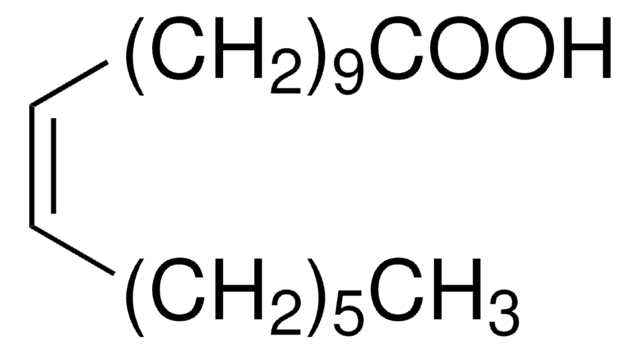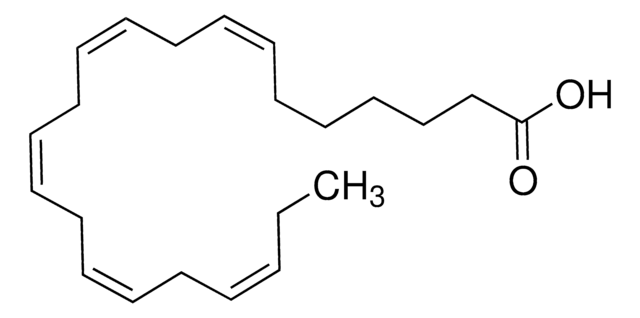69301
cis-Vaccenic acid
analytical standard
Synonyme(s) :
octadec-11(cis)-enoic acid, cis-11-Octadecenoic acid
About This Item
Produits recommandés
Qualité
analytical standard
Pureté
≥97.0% (HPLC)
Forme
liquid
Durée de conservation
limited shelf life, expiry date on the label
Impuretés
≤0.5% trans-isomer
Indice de réfraction
n20/D 1.459 (lit.)
Point d'ébullition
150 °C/0.03 mmHg (lit.)
Pf
14-15 °C (lit.)
Densité
0.887 g/mL at 25 °C (lit.)
Application(s)
clinical testing
Température de stockage
−20°C
Chaîne SMILES
CCCCCC\C=C/CCCCCCCCCC(O)=O
InChI
1S/C18H34O2/c1-2-3-4-5-6-7-8-9-10-11-12-13-14-15-16-17-18(19)20/h7-8H,2-6,9-17H2,1H3,(H,19,20)/b8-7-
Clé InChI
UWHZIFQPPBDJPM-FPLPWBNLSA-N
Vous recherchez des produits similaires ? Visite Guide de comparaison des produits
Description générale
Application
- Quantification of the analyte and its photodegradation products in marine samples using gas chromatography coupled to electron impact mass spectrometry (GC-EIMS). The photo-oxidation of the lipid components of the two strains of aerobic photoheterotrophic bacteria, Erythrobacter sp. strain NAP1 and Roseobacter-related isolate COL2P is studied and the results obtained after irradiation of axenic and nonaxenic cultures of the diatom, Skeletonema costatum is compared.
- Quantification of the analyte in the methanolic extract of the leaves of Lepidium sativum using gas chromatography coupled to mass spectrometry (GC-MS).
- Quantification of the analyte in methanolic extract of Rosmarinus oficinalis leaves using gas chromatography coupled to mass spectrometry and Fourier transform infrared spectroscopy.
Produits recommandés
Code de la classe de stockage
10 - Combustible liquids
Classe de danger pour l'eau (WGK)
WGK 3
Point d'éclair (°F)
446.0 °F - closed cup
Point d'éclair (°C)
230 °C - closed cup
Faites votre choix parmi les versions les plus récentes :
Déjà en possession de ce produit ?
Retrouvez la documentation relative aux produits que vous avez récemment achetés dans la Bibliothèque de documents.
Notre équipe de scientifiques dispose d'une expérience dans tous les secteurs de la recherche, notamment en sciences de la vie, science des matériaux, synthèse chimique, chromatographie, analyse et dans de nombreux autres domaines..
Contacter notre Service technique







